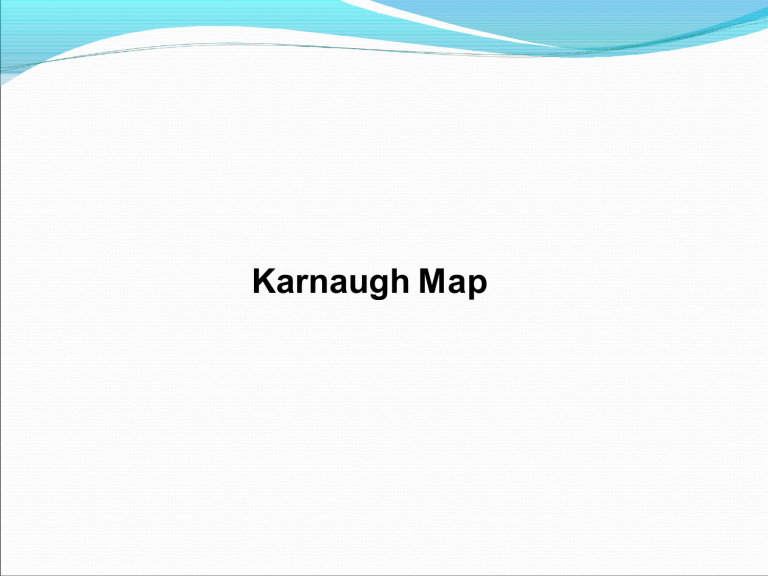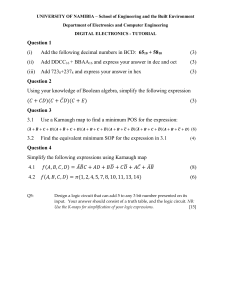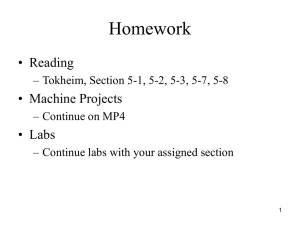
Karnaugh Map
The Karnaugh map, also known as the K-map, is a method to simplify boolean
expressions.
The Karnaugh map reduces the need for extensive calculations by taking
advantage of humans' pattern-recognition capability.
The required boolean results are transferred from a truth table onto a twodimensional grid where the cells are ordered in Gray code, and each cell
position represents one combination of input conditions, while each cell value
represents the corresponding output value. Optimal groups of 1s or 0s are
identified.
These terms can be used to write a minimal boolean expression representing
the required logic.
Karnaugh Maps - Rules ofSimplification
The Karnaugh map uses the following rules for the simplification of
expressions by grouping together adjacent cells containing ones.
1.Groups may not include any cell containing a zero.
2.Groups may be horizontal or vertical, but not
diagonal.
3. Groups must contain 1, 2, 4, 8, or in general 2ncells.
That is if n = 1, a group will contain two 1's since 21= 2.
If n = 2, a group will contain four 1's since 22= 4.
4. Each group should be as large as possible.
5.Each cell containing a one must be in at least one group.
6.Groups may overlap.
7.Groups may wrap around the table.
The leftmost cell in a row may be grouped with the rightmost
cell and the top cell in a column may be grouped with the
bottom cell.
8. There should be as few groups as possible, as longas
this does not contradict any of the previous rules.
Summmary:
No zeros allowed.
No diagonals.
Only power of 2 number of cells in each group.
Groups should be as large as possible.
Every one must be in at least one group.
Overlapping allowed.
Wrap around allowed.
Fewest number of groups possible.
Two Variable K-Map
Three Variable K-Map
4 Variable K - Map
Example 1:
Consider the following map. The function plotted is: Z = f(A,B) = A +AB.
Note that values of the input variables form
the rows and columns.
That is the logic values of the variables A and B
(with one denoting true form and zero
denoting false form) form the head of the rows
and columns respectively.
The map displayed is a one dimensional type which can be used to
simplify an expression in two variables.
There is a two-dimensional map that can be used for up to four
variables, and a three-dimensional map for up to six variables.
Referring to the map above, the two adjacent 1's are grouped
together.
Through inspection it can be seen that variable B has its true and
false form within the group.
This eliminates variable B leaving only variable A which only has its
true form.
The minimized answer therefore is Z = A.
By convention, we represent the minterms by a "1" in
the map and leave the other terms blank. A function
table would also show the "0" terms.
Example:
m(2,3,4,5)
yz=00 yz=01 yz=11 yz=10
x=0
x=1
1
1
1
1
yz=00 yz=01 yz=11 yz=10
Example:
m(3,4,6,7)
x=0
x=1
1
1
1
1
Example: Let F = m(2,3,6,7)
F
yz=00
yz=01
yz=11
yz=10
x=0
1
1
x=1
1
1
Applying the Minimization Theorem three times:
F ( x, y , z ) x y z x y z x y z x y z
yz y z
y
Thus the four terms that form a 2 × 2 square correspond to
the term "y".
It is used to minimize number of
logic gates required.
Example 2: Take the Boolean or
binary function described by
the truth table.
A
B
C
D
f(A, B, C, D)
0
1
0
0
0
0
0
0
0
1
0
0
2
0
0
1
0
0
3
0
0
1
1
0
4
5
0
0
1
1
0
0
0
1
0
0
6
0
1
1
0
1
7
8
0
1
1
0
1
0
1
0
0
1
9
1
0
0
1
1
10 1
0
1
0
1
11
1
0
1
1
1
12 1
1
0
0
1
13 1
1
0
1
1
14 1
15 1
1
1
1
1
0
1
1
0
The values in side
are the minterms to map (i.e. rows which have output 1 in the truth table).
In this case, the four input variables can be combined in 16 different
ways, so the truth table has 16 rows, and the Karnaugh map has 16
positions.
The Karnaugh map is therefore arranged in a 4 × 4 grid.The row and
column values (shown across the top, and down the left side of the
Karnaugh map) are ordered in Gray code rather than binary
numerical order.
Gray code ensures that only one variable changes between each pair
of adjacent cells. Each cell of the completed Karnaugh map contains
a binary digit
representing
the function's output for that
combination of inputs
After the Karnaugh map has been constructed it is used to find one of the
simplest possible forms for the information in the truth table.
Adjacent 1s in the Karnaugh map represent opportunities to simplify the
expression. The minterms ('minimal terms') for the final expression are found
by encircling groups of 1sin the map.
Minterm groups must be rectangular and must have an area that is a power of
two (i.e. 1, 2, 4, 8…). Minterm rectangles should be as large as possible without
containing any 0s. Groups may overlap in order to make each one larger.
The grid is toroidally connected, which means that rectangular groups can
wrap across the edges. Cells on the extreme right are actually 'adjacent' to those
on the far left. similarly, so are those at the very top and those at the bottom.
Therefore a valid term includes cells 12 and 8 at the top, and wraps to the
bottom to include cells 10and 14 , which includes the four corners.
Once the Karnaugh map has been constructed and the adjacent 1s linked by rectangular
and square boxes, the algebraic minterms can be found by examining which variables
stay the same within each box.
For the redgrouping:
The variable A is the same and is equal to 1 throughout the box, therefore it should be
included in the algebraic representation of the red minterm.
Variable B does not maintain the same state (it shifts from 1 to 0), and should
therefore beexcluded.
C does not change. It is always 0 so its complement, NOT-C, should be included
thus,.
D changes, so it is excluded aswell.
Thus the first minterm in the Boolean sum-of-products expression is .
For the green grouping, A and B maintain the same state, while C and D change. B is
0 and has to be negated before it can be included.Thus the second term is.
In the same way, the blue grouping gives the term .
The solutions of each grouping are combined .
Thus the Karnaugh map has guided a simplification of
to
Inverse
The inverse of a function is solved in the same way by grouping the 0s
instead.
The three terms to cover the inverse are all shown with grey boxes with
different colored borders. This yields the inverse:
Through the use of De Morgan law the product of sums can be
determined:
Don't cares are usually indicated on the map with a dash or X.
Karnaugh maps also allow easy minimizations of functions whose truth
tables include “don’t care”
conditions.
A "don't care" condition is a combination of inputs for which the designer
doesn't care what the output is.
Therefore "don't care" conditions can either be included in or excluded
from any circled group, whichever makes it larger. They are usually
indicated on the map with a dash or X.
The example on the right is the same as the example above but with the
value of F for ABCD = 1111replaced by a "don't care". This allows the red term to
expand all the way down and, thus, removes the green term completely.
This yields the new minimum equation:
Note that the first term is just A not AC . In this case, the don't care
has dropped a term (the green); simplified another (the red); and
removed the race hazard (the yellow as shown in a following
section).
The inverse case is simplified as follows (SOP)
F (W,X,Y,Z)= WX’Y’ + WY + W’YZ’

